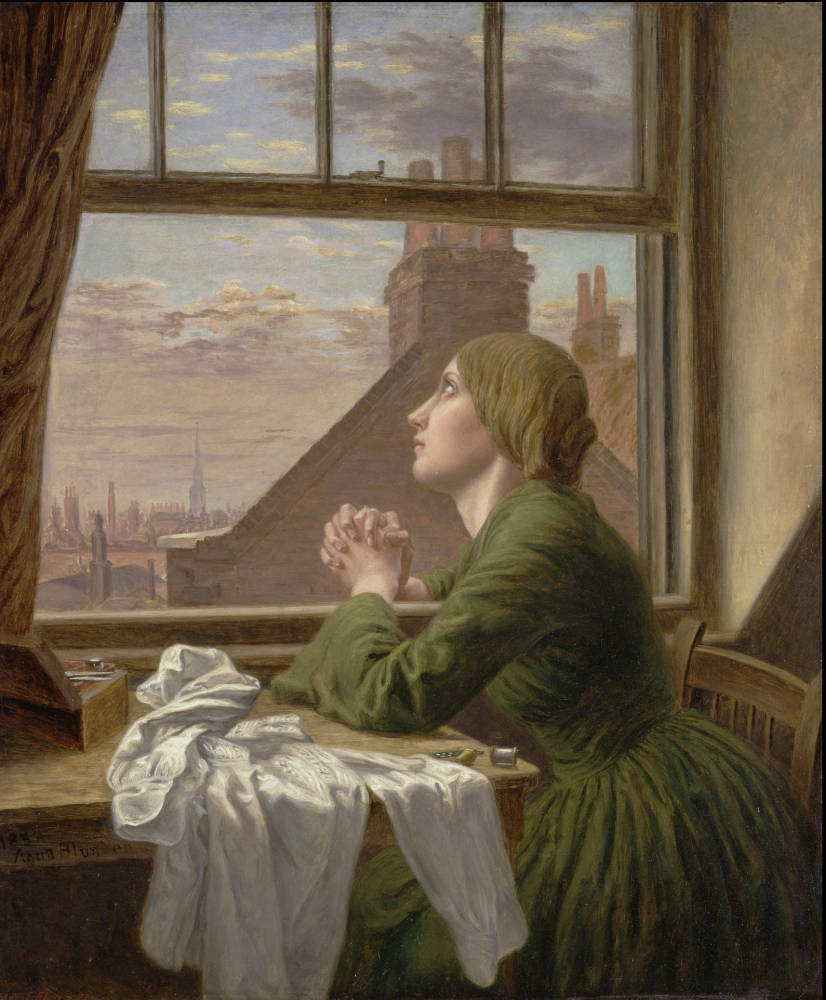
The Irish Vagrants, 1853-54. Oil on canvas, 2415/16 x 303/8 inches (63.4 x 77.2 cm). Collection of Johannesburg Art Gallery.
In March 1853 Deverell recorded in his journal: To the picture of Irish Vagrants did very little this month. If any of the pictures are rejected [at the Royal Academy] I should prefer it to be this – Rossetti seemed of opinion that I should not exhibit it this year. As the subject was so good & important I had better paint it on a larger scale – I must confess however that I myself do not regard it with less partiality - The stern head of the Irish woman seems to offend greatly the few casual visitors I have had tho’ it is certainly one of the most just & natural expressions I have ever done” (Lutyens, 89). The painting was left unfinished at Deverell’s death but x-rays showed part of the background was painted out at some point. If this work was one of his paintings rejected for the Royal Academy exhibition of 1853 perhaps he decided to repaint portions of it at that point but just never completed it. Deverell was definitely working on the picture later in 1853 and it was one of the paintings he took with him to work on after the family moved from Kew to Chelsea following the death of his father.
This painting is a good example of a social realist painting from this time, similar to other works commenting of the plight of the poor such as G. F. Watts’s The Irish Famine of 1848-50, Anna Blunden’s The Song of the Shirt of 1854, and Henry Wallis’s The Stonebreaker of 1857.



Left: The Irish Famine. George Frederic Watts RA (1817-1904). 1850<. Oil on canvas. 198 x 180.3 cm. Courtesy the Watts Gallery, Compton. Middle: "For Only One Short Hour" [The Song of the Shirt]. Anna Elizabeth Blunden (Mrs. Martino). 1854. Oil on canvas, 18 ½ x 15 ½ inches (47 x 39.4 cm) Right: The Stonebreaker. Henry Wallis. 1857-58. Birmingham City Museum and Art Gallery. Oil on canvas, 25 3/4 x 31 inches. [Click on images to enlarge them.]
Deverell’s painting relates to the influx of poor Irish into England trying to escape starvation in the wake of the severe Irish famines of 1845-51. The picture shows an Irish pauper family beside a country roadside. One man sitting up appears defeated and dejected and looks straight ahead while another exhausted man lies down to sleep. A woman with an infant clasped to her back looks defiant and angry in her despair. There is no doubt, however, that Deverell has well captured the look of desperation in the faces of these Irish vagrants. The adults are accompanied by two half naked urchins, one of whom is begging for alms from a well-to-do lady riding by but she passes them indifferently. Irish immigrants had few prospects at that time other than to become casual field labourers or to crowd into the slums of the cities and try to eke out a living the best they could in the lowliest of unskilled urban occupations. Holman Hunt in his book on Pre-Raphaelitism commented about Deverell that: “He was an eager reader, and had contracted the prevailing taste among the young of the day…for dwelling on the miseries of the poor, the friendless and the fallen, and with this special interest he had, perhaps all the more, a general sympathy for all social and human concerns” (I, 197).
Bibliography
Hunt, William Holman. Pre-Raphaelitism and the Pre-Raphaelite Brotherhood. 2 vols. London: Macmillan & Co. 1906,
Lutyens, Mary. “Walter Howell Deverell.” Ed. Leslie Parris. Pre-Raphaelite Papers. London: The Tate Gallery and Allen Lane, 1984.
Last modified 9 March 2022